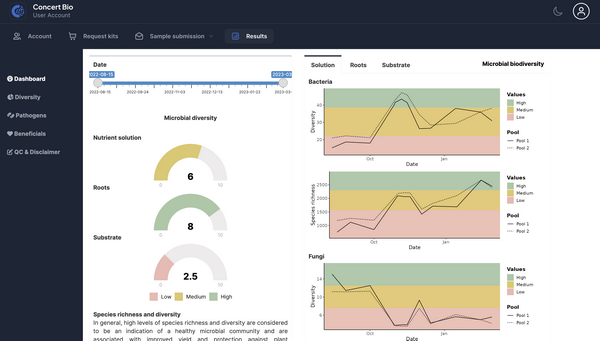Although using microbes in traditional soil agriculture is very well established, the same can’t be said for soilless cultivation. “In this space, there’s an understanding that microbes in the system are crucial, but there’s simply a lack of tools to understand everything that goes on in there. So, growers usually resort to bleach or ozone to get rid of the bad microbes, which also kills the good microbes in the process,” says dr. Paul Rutten, founder and CEO of Concert Bio.
Plants usually get their necessary microbes from the soil, but in soilless cultivation, this can’t happen since the number of microbes there is much lower. Paul points out that, “Bluntly put, plants grown in soilless conditions are microbially deprived. The issue with that is that if a plant is lacking microbes, then something else may take their place, and more often than not that is a gateway for pathogens.” This also means that providing plants with an optimal microbiome can enhance their growth, both in terms of yield and quality.

Paul Rutten
Controlling the microbiome
That’s why Paul and Concert Bio have been working hard to develop a way for growers to control the microbiome. “Controlling the microbiome is like getting the right temperature in the greenhouse,” he says. “And to do that, you need tools such as a thermometer, for instance. Basically, what we did, was develop a thermometer for the microbes.” By using next-gen sequencing, Concert Bio can analyze the entirety of a given microbiome, instead of testing for just a set of bacteria. “By getting all this data and metadata, we can use machine learning to understand what microbes would improve the yield, or if there are signs that an outbreak is going to occur.”
According to Paul, such a solution can be potentially disruptive as it gives CEA growers a means to control something that was previously left to chance. “We can see what proportion of the microbial community a given microbe takes up, and how it evolves. You can then ask AI to find the microbe that correlates the most with yield, and a grower can make an informed decision based on that. But we can also use AI to find microbes correlated with lower yield and see how those are impacted by pH. All of this is to give growers further control over their operations."

Paul and his team have been working with many growers who also wanted to know more about the origin of the microbiomes in their cultivation. They want to know where the microbes come from. The system can look at the substrate and the roots and analyze the nutrient solutions, and even swab workers’ hands. That gives a sense of what microbes come from the substrate, what percentage from the nutrient solutions, and whether their origin is known or unknown. According to Paul, this also serves to predict potential diseases and stop outbreaks before they happen.
Growing capacity
Concert Bio has been doing a pilot in the UK and the US over the last year, and now the solution is moving to the beta phase. To scale up their effort, Concert Bio is also going to have a new round of investments, so as to have more capacity for other growers jumping on this microbiome wagon. “At the current rate, we will run out of capacity to take on more customers,” Paul says.
At the same time, to spread awareness of the importance of microbes in soilless cultivation, Paul gave a keynote at the recent CEA 4.0 conference. “The point I want to get across the most is that CEA growers shouldn’t ignore the microbe content in their cultivations, rather they should harness and control this ecosystem. During the talk, I introduced microbiomes and our system, what we are trying to achieve with the monitoring, and where we think this space is going.”
 For more information:
For more information:
Concert Bio
Paul Rutten, Founder and CEO
paul@concert.bio
www.concert.bio
